Notes: Baschurch was located on the Shrewsbury & Chester Railway (S&CR) which opened throughout on 14 October 1848. The S&CR was formed in July 1846 out of a merger of the North Wales Mineral Railway (NWMR) and the Shrewsbury, Oswestry & Chester Junction Railway (SO&CJR). The SO&CJR was set up to create a route between Shrewsbury and Chester and the merger enabled that task to be carried out through an extension of the NWMR line which had been authorised in 1844. The first section of the line opened between Saltney Junction and a temporary railhead at Rhosymedre on 4 November 1846.
Baschurch opened when the line was completed on 14 October 1848. It was located 7¾ miles to the north of Shrewsbury to the north-east of its namesake. The station was to the south of the Baschurch – Marton Road (the present day B4397) which passed over the line by means of a level crossing.
The main facilities were located on the down (Chester direction) side of the line. The impressive building (now Grade II listed, but looking somewhat shabby) housed the booking office, waiting rooms and staff accommodation. It was one of a series of fine station buildings by the architect T M Penson of Chester, most of them in Tudor cottage ornée style. Baschurch has a two-storeyed stuccoed house with a single-storey office range adjoining. There is a profusion of steep gables with heavy, elaborate bargeboards and a charming front porch. For some reason this station was favoured with a low tower on the forecourt elevation with chevron stripes embellishing the gables, but it was reduced to roof height in 1921. Biddle (2003) notes how this process was carried out with great respect for the original design. The angled chimneystacks have gone although the crossing keeper’s cottage next to the level crossing still has them. Until the 1970s the cottage had remarkable multi-light windows. Between the two is a pretty little square, red sandstone pump house with a pavilion roof which has retained its tall finial and a lofty round-headed fan window. In comparison to the generous provision of buildings on the down side, the up platform’s provision was somewhat modest. The brick shelter with a gently-sloping roof carried an attractive timber canopy with serrated valances.
.gif) The goods facilities were west of the line to the south of the passenger station and included sidings, a goods shed, a loading ramp, a 3-ton lifting crane and cattle pens. The goods facilities were west of the line to the south of the passenger station and included sidings, a goods shed, a loading ramp, a 3-ton lifting crane and cattle pens.
The March 1850 timetable showed six trains in each direction Monday-to-Saturday and two each way on Sundays. The up trains all ran to Shrewsbury and the down to Chester.
From 1880 there was a signal box at Baschurch, now Grade II listed. (A modern semaphore signal close to the box shares this listed statues.) It was located at the north end of the up platform adjacent to the level crossing. It had a 29-lever frame and controlled the crossing, the main line and the points that gave access to the goods yard. By this time to the south of the station on the down side of the line there were two long sidings. One was called the No.1 Refuge Siding; it was close to the down line running parallel to it. The siding was 431yd long and its purpose was to allow goods trains to be taken off the main line to allow express passenger services to pass. The other was No.2 Down Siding and it linked into the goods yard.
The December 1895 timetable showed six up and eight down trains Monday-to-Saturday. There was an extra down on Wednesdays and on Saturdays there was a service that comenced from Baschurch and ran to Shrewsbury at 8.20am. On Sundays there was one up and two down trains.
In 1903 27,826 passenger tickets were sold at Baschurch station and 14,535 parcels were handled. The goods yard forwarded 1,182 tons of general goods and received 6,508 tones. It also handled 3,715 tons of coal and coke and 451 wagons of livestock.
There had been moderate passenger growth by 1913 Baschurch with 29,351 tickets sold. Parcels traffic growth was phenomenal with 35,200 being handled. General goods received amounted to 6,588 tons and forwarded 1,717 tons. Coal and Coke handled amounted to 4,066 tons and 585 trucks of livestock were handled.
The July 1922 timetable showed seven up six down services Monday-to-Saturday as shown in the table below. There were two trains each way on Sundays.
| Up Trains July 1922 |
Destination |
Down Trains July 1922 |
Destination |
| 7.40am |
Shrewsbury |
8.04am |
Chester General |
| 8.41am |
Paddington |
10.19am |
Chester General |
| 9.08am |
Shrewsbury |
11.43am |
Wrexham General |
| 12.57pm |
Shrewsbury |
3.19pm |
Wrexham General |
| 3.35pm |
Shrewsbury |
5.17pm |
Wrexham General |
| 7.38pm |
Birmingham Snow Hill |
6.59pm |
Chester General |
| 8.56pm |
Shrewsbury |
|
|
The year 1923 saw a drop in passenger tickets sold there being 21,009. Parcels traffic had continued to expand however with 57,571 being handled. The goods yard remained busy and the station had a staff of 13 men at this time.
By 1933 passenger ticket sales were down to 14,865 probably because of competition from bus services. Parcels traffic had continued to grow and in that year 88,261 were handled. The goods yard experienced a drop in all types of goods except coal and coke which amounted to 4,453 tons in that year.
On 1 January 1948 Baschurch became part of British Railways [Western Region] (BR[WR]). The summer timetable for 1949 showed six up and four down trains Monday-to-Saturday. On Sundays there were two up and three down services.
.gif) The BR[WR] timetable of 15 September 1958 showed four trains in each direction Monday-to-Friday. There was an extra up service on Saturdays but no trains on Sundays. The BR[WR] timetable of 15 September 1958 showed four trains in each direction Monday-to-Friday. There was an extra up service on Saturdays but no trains on Sundays.
BR[WR] withdrew passenger services from Baschurch, along with many other of the Chester-Shrewsbury roadside stations, on 12 September 1960.
At 7.35pm on Monday 13 February 1961 there was a serious accident at Baschurch station in which three railway employees were killed. The accident involved a Coton Hill to Saltney goods train and a Wellington to Chester General passenger train. The goods train arrived at Baschurch station shortly after 7.14pm. The driver was instructed to set back into the No.1 Down Refuge Siding so that the passenger train could pass. The goods train failed to make it fully into the siding because the driver felt resistance when setting back. Thinking he had backed into the buffer stop at the end of the siding he stopped his train when it was still partly on the down main line and got out to check what had happened. The signalman thought that the goods train was fully in the siding and he set the down line for the passenger service. He had no reason to suppose that the goods train was not in the siding as it had not given the signal (three whistles) to say that it was. The driver of the goods train noticed that the signals had been set on the down main line and he assumed that the signalman had changed his mind and now wanted him to proceed northwards with his goods train. He climbed into the cab and set off. By that time the passenger train was travelling at a speed of about 40mph in the same section and it smashed into the goods train killing the driver and fireman. The engine of the passenger train turned over onto its side lying across the up line. Behind the engine there was a stores van which ended up on the up platform where it caught fire. A storesman in the van was the other fatality.
The fire brigade arrived within five minutes but they were unable to tackle the fire until a water tender arrived as there was no hydrant at the station. Seven people were taken to hospital.
Breakdown equipment was brought to Baschurch from Shrewsbury, Chester and Wolverhampton and the up line was cleared by 1.25pm on 14 February 1961. Single-line working was introduced on the up line until 5.18pm the next day by which the down line was clear.
.gif) The accident report placed the blame on the signalman for not ensuring that the goods train was in the siding. Secondary factors were cited including the goods train guard who applied the brake van brakes too much when the train was setting back. In doing so he created the resistance which the driver mistakenly thought was his train running up against the buffers. The accident report placed the blame on the signalman for not ensuring that the goods train was in the siding. Secondary factors were cited including the goods train guard who applied the brake van brakes too much when the train was setting back. In doing so he created the resistance which the driver mistakenly thought was his train running up against the buffers.
A recommendation of the report was that the No.1 Down Refuge Siding be converted into a loop by the installation of a facing set of points on the down line at the southern end of the siding. This would mean that trains would no longer have to set back. The recommendation was followed and the work was carried out.
On 1 January 1963 Baschurch became under the operational control of British Railways [London Midland Region] (BR[LMR]) and transferred fully to them on 1 July 1963. BR[LMR] closed Baschurch for goods services on 5 July 1965.
The platforms were demolished after closure but the station building, pump house and crossing keeper’s cottage survive.
The down side loop survived until 28 March 1999 when the signal box was closed. It was extant (being a listed structure, as noted above)when the station was visited on 23 November 2015.
Tickets from Michael Stewart and route map by Alan Young
Sources:
- A Regional History of the Railways of Great Britain - Volume II North & Mid Wales - Peter E Baughan - David & Charles 1980.
- Encyclopaedia of British Railway Companies - Christopher Awdry - Guild Publishing 1990.
- Paddington to the Mersey - Dr R. Preston Hendry & R. Powell Hendry - Oxford Publishing Company 1992.
- Railway Passenger Stations in Great Britain - a Chronology - Michael Quick - Railway & Canal Historical Society 2009.
- Shrewsbury to Chester - Vic Mitchell & Keith Smith - Middleton Press 2010.
To see the
other closed stations on the Shrewsbury - Chester General line
click on the station name: Shrewsbury S&C, Leaton, Oldwoods Halt, Stanwardine Halt, Haughton Halt, Rednal & West Felton, Whittington Low Level, Weston Rhyn, Trehowell Halt, Llangollen Road, Whitehurst Halt, Rhosymedre, Cefn, Rhosymedre Halt, Wynnville Halt, Johnstown & Hafod, Rhos, Rhosrobin
Halt, Gresford, Rossett, Pulford, Balderton and Saltney |

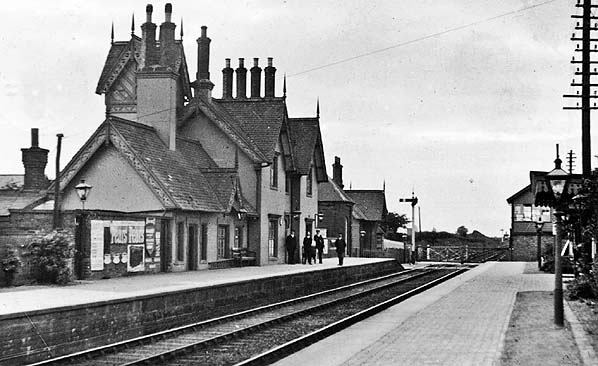
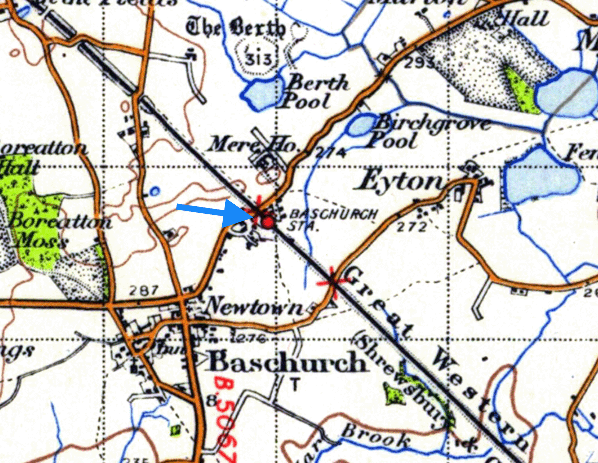
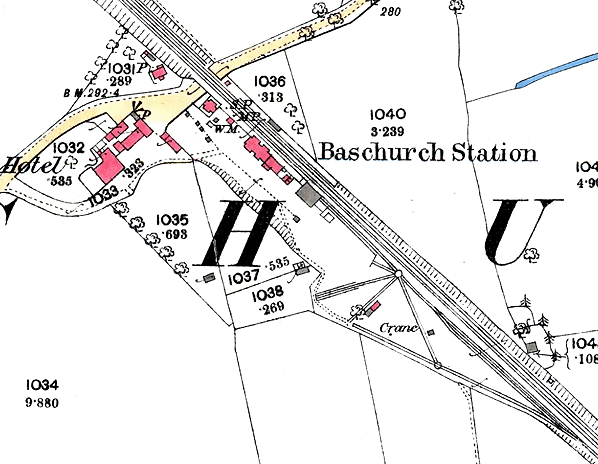
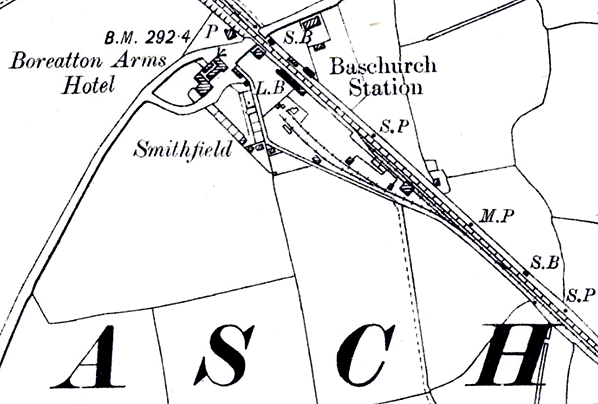
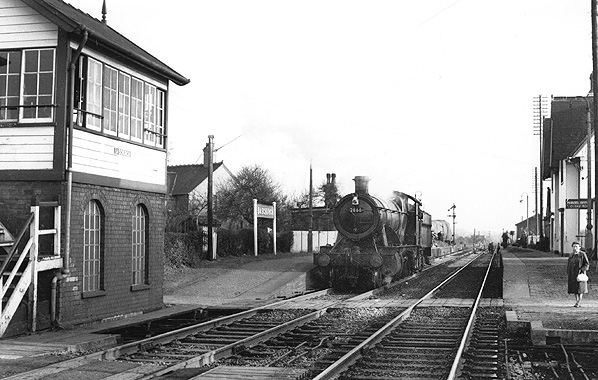 A view looking south at Baschurch station in the 1950s as a light engine heads south.
A view looking south at Baschurch station in the 1950s as a light engine heads south.
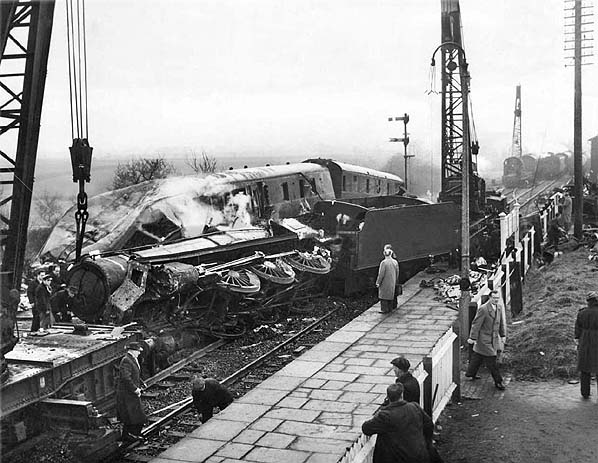
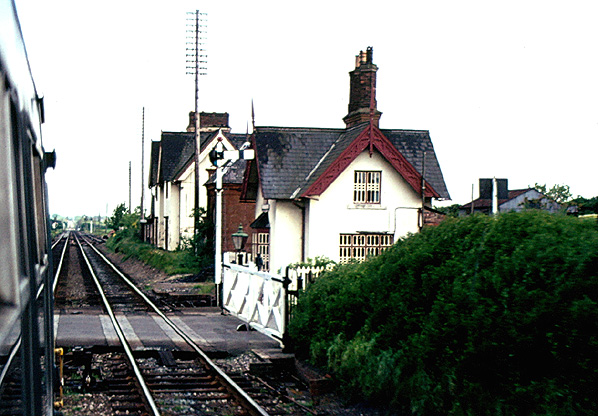

.jpg)
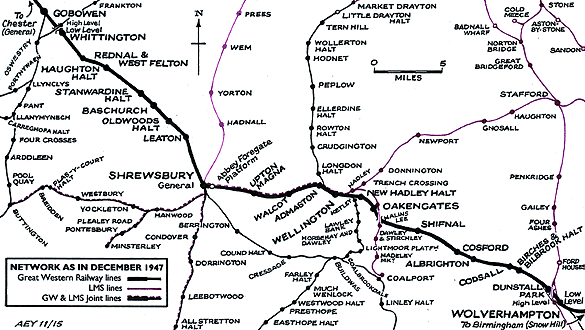
.gif) The goods facilities were west of the line to the south of the passenger station and included sidings, a goods shed, a loading ramp, a 3-ton lifting crane and cattle pens.
The goods facilities were west of the line to the south of the passenger station and included sidings, a goods shed, a loading ramp, a 3-ton lifting crane and cattle pens. .gif) The BR[WR] timetable of 15 September 1958 showed four trains in each direction Monday-to-Friday. There was an extra up service on Saturdays but no trains on Sundays.
The BR[WR] timetable of 15 September 1958 showed four trains in each direction Monday-to-Friday. There was an extra up service on Saturdays but no trains on Sundays. .gif) The accident report placed the blame on the signalman for not ensuring that the goods train was in the siding. Secondary factors were cited including the goods train guard who applied the brake van brakes too much when the train was setting back. In doing so he created the resistance which the driver mistakenly thought was his train running up against the buffers.
The accident report placed the blame on the signalman for not ensuring that the goods train was in the siding. Secondary factors were cited including the goods train guard who applied the brake van brakes too much when the train was setting back. In doing so he created the resistance which the driver mistakenly thought was his train running up against the buffers. 
 Home Page
Home Page